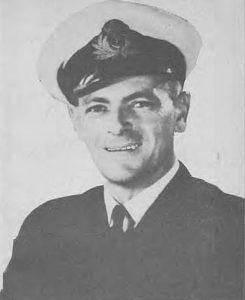- Author
- Downs, Ian G F
- Subjects
- History - general
- Tags
-
- RAN Ships
- None noted.
- Publication
- January 1972 edition of the Naval Historical Review (all rights reserved)
Commander Feldt’s efforts to obtain assistance and rescue operations for his men were handicapped by the tense defensive operations in which all allied forces were then engaged, but assistance was generously given when this was at all practicable and in the months ahead US submarines, then aircraft of both the RAAF and the USAAF brought supplies and landed or picked up Coastwatchers, often at great risk to themselves.

Coastwatcher in North Bougainville, 1942-43
Meanwhile, further to the east, events were moving rapidly down the island chain from Rabaul to the Solomons where high island mountains command deep channels between tropical islands of unforgettable beauty. Bougainville, The Shortlands, Choiseul, Vella Levella, Kolombargara, Rendova, were all guardians of sea lanes leading to the passage of blue water between New Georgia and Santa Isobel that fighting men called ‘The Slot.’ Eastwards the passage narrows with the broad island of Guadalcanal on the south and the long dark shape of Malaita to the north. The approach between these islands is divided by Tulagi in the small Florida group facing the northern slopes of Guadalcanal and by the conical peak of Savo lying off the western end of the same island. These are all names that thousands of Americans and those who served with the Australian Squadron will always remember. For Coastwatchers, starting with Bougainville, they are a roll of honour. Coastwatchers were eventually operating from all the main islands and even from the distant atolls of Rennel in the South East and Ontong Java, 300 miles to the north of Guadalcanal. They observed and made their reports of enemy activity despite harassment from Japanese patrols and without any possibility of rescue or retreat. The waters off Guadalcanal and east of Savo became known as ‘Iron Bottom Sound’ and the long savage struggle for the Solomons and the base of Guadalcanal attracted major forces from both sides. This allied victory was the climax of the war for the South West Pacific.
The Japanese occupied Sohano in Buka Passage (between Buka Island and Bougainville) at the end of March 1942, and began to occupy all the important points of the main island. At about the same time, American forces had occupied New Caledonia and the New Hebrides. In May, the Japanese swept eastward to the grassy coastal plains of Guadalcanal’s north coast. In June, the battle of Midway arrested Japan’s unlimited control of the sea and gave back some initiative to the Americans. Their first move was to make a major amphibious assault to capture the Japanese base on Guadalcanal and turn it into an allied airfield. This became known as Henderson Field and was held by American Marines and Army divisions with great tenacity against daily attacks from the enemy, which continued for many months. In November 1942 the Japanese made another supreme effort which was only defeated after very bitter fighting.
Almost all the sea and air attacks and the convoys of Japanese troops were staged or assembled from Rabaul and harbours in Bougainville and New Ireland. Many large sea and air formations were involved and nearly all of them were observed and reported – first by Read from northern Bougainville and then by Mason – operating in the southern sector of the same large island. Their reports were relayed, confirmed or amplified by the expanding screen of observers occupying positions in other islands at different crossroads on the way to Guadalcanal. Recognition and description of types of planes and ships became expert and familiarity with enemy habits made it possible to anticipate major attacks or the assembly of a convoy of troops. Read and Mason were forced off the air on only a few occasions. Allied forces were often able to destroy attacks before they could be developed and defending fighter aircraft were ready at high altitude to repel Japanese raids when they arrived.
A situation was developed in which the Coastwatchers had their own communications centre at Lungoa, close to Henderson Field. Direct listening watches were kept by ships on the Coastwatchers’ frequency and their reports were broadcast to the whole of the Pacific from Pearl Harbour. Codes were improved and simplified, but for a period the urgency of the signals dictated that they should be made in plain language so that ships could rapidly disperse and ground forces react to the warning of air attack.




